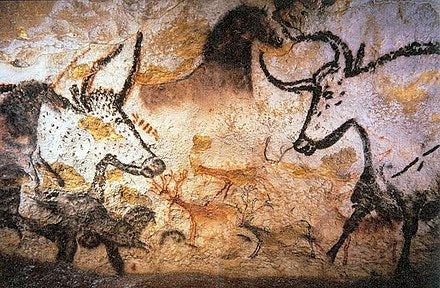
The Birth of Graffiti: Ancient Rock Art and Cave Paintings
Share
Graffiti as we know it may feel modern, but its roots reach back tens of thousands of years to the earliest marks made by humans. From prehistoric cave art to ancient inscriptions, these expressions of creativity and communication provide a direct link to our ancestors' lives, beliefs, and environments.
Prehistoric Cave Paintings: Humanity’s First Art Galleries
Some of the earliest known cave paintings, such as those in Lascaux, France, and Chauvet Cave, date back over 30,000 years. These sites feature intricate depictions of animals like bison, horses, and lions, rendered with a remarkable sense of movement and detail. Created with natural pigments like ochre and charcoal, these works likely held spiritual or ceremonial significance, as many were located deep within cave systems, accessible only by torchlight. Lascaux, for instance, is so elaborate that it’s often called “the Sistine Chapel of Prehistory” (Metropolitan Museum of Art).
Equally captivating are the hand stencils found in places like Cueva de las Manos in Argentina, where negative imprints of hands were created by blowing pigment through hollow bones. These human signatures, dating back around 9,000 years, provide an intimate glimpse into the lives of our prehistoric ancestors (ThoughtCo).
Ancient Civilizations: Graffiti Takes Shape
In ancient Egypt, Greece, and Rome, graffiti evolved into a form of public commentary. Egyptian tombs were adorned with inscriptions detailing the lives of their occupants, while Greek artisans etched humorous or political notes onto pottery. Roman graffiti, often found in Pompeii, is strikingly modern, featuring political slogans, love declarations, and even lewd jokes. These carvings and writings reveal the day-to-day thoughts of ordinary people, offering a democratized version of history often missing from grander monuments.
A Legacy That Lives On
The significance of these ancient markings transcends art; they represent the human need to communicate, to leave a mark, and to share stories. From the cave walls of Chauvet to the bustling streets of modern cities, graffiti continues to challenge societal norms and express individuality.
For more about these incredible sites and their historical significance, check out these resources:
- Lascaux Cave (Metropolitan Museum of Art)
- Altamira Cave and Others (ThoughtCo)
At Kaos Kouture, part of GrafPunk.com, we aim to explore these ancient roots and their influence on today's street art and fashion. Just as our ancestors left their handprints on cave walls, today's artists leave their mark through bold designs on T-shirts, hoodies, and streetwear. Join us as we trace this continuum of human creativity!
